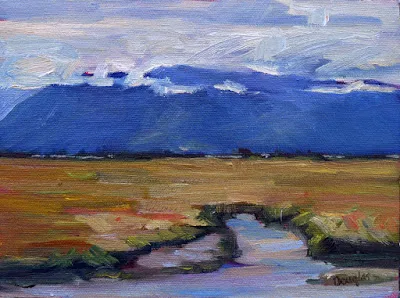My guest expert (my daughter) wrote this post in 2018, because I was indisposed due to medical tests. I’m having tests again today (one of life’s eternal verities) and was reminded of this classic.
 |
|
The Road to Seward, Alaska, by Carol L. Douglas
|
Dear Carol,
Last week, you mentioned the wild turkeys near your residency. I am, unfortunately, afflicted with both hoplophobia and meleagrisphobia – fears of guns and those creatures most fowl. When is it appropriate to pepper spray a turkey?
Yours, Allie N., New Mexico
Allie,
I have good news and I have bad news. As of 1992, the EPA was still looking for data on the effectiveness of capsaicin (the active spicy spice that makes spices spicy) against birds.1They accepted that it was probably effective against birds, in addition to other animals. Obviously, it has been several years since then. Two scientists at the University of California, San Francisco, discovered in 2002 that, while birds have the vanilloid receptors that taste capsaicin for us, theirs are immune to capsaicin.2 In conclusion, you could probably pepper spray a turkey and it would irritate and startle him. However, you’d get the same effect by shrieking and flapping your arms wildly. In my opinion, the perfect time to pepper spray a turkey is directly before he goes into the oven.
Mary Helen
 |
|
The Alaska Range, by Carol L. Douglas
|
Greetings Carol,
It’s my favorite time of year here in Success, Saskatchewan – the air is crisp and clear, the leaves are changing, and it’s finally moose season. I can’t wait to make all my favorite moose recipes once my wife comes back from hunting. Moose chili, moose enchiladas, moose tartare, coleslaw with moose meatballs, moose bulgogi – you name it, I’ll eat it! I love going with my wife on her hunting trips all around the wilderness of Saskatchewan. You’ve been there. You know how it is! It’s a great time to do some plein airpainting while enjoying some quality time with the missus. How can I best keep myself from getting mistaken for a moose? You know, we share so many of the same features.
Bill Winkleman, Saskatchewan
Bill,
Moose season in Saskatchewan this year is from October to December. Soon it will be too cold to do much painting en plein air. However, here’s good advice on how to avoid being mistaken for a large ungulate:
- Wear brightly-colored clothing when out in the woods. I recommend a large, heavily starched tie-dye wizard’s hat.
- Try to sing as loudly as possible at all times. It’s common knowledge that moose are fans of jazz and Scandinavian black metal, so stick to old pop standards and famous Canadian sea shanties.
You may find that when you’re painting en plein air, you may find moose walking around en trails. Worse than that, you may find that some enterprising hunter has left moose entrails en trails and you have to walk gingerly. I recommend wellies.
Mary Helen
 |
|
Confluence, by Carol L. Douglas
|
Carol –
My Oma and I are planning a cycling trip up the Alaska Highway next summer. We’ve already begun shopping for a truly inspiring collection of very tight, padded shorts and we’ve got our cameras ready to see all the wildlife. How do you get your best photos of bears?
Hildegard
Hildy,
It’s GREAT to hear from you again! My advice for taking photos of bears from your bicycle from the shoulder of the Alaska highway is, uh, DON’T!
Black bears can run between 25 and 30 miles an hour and brown bears can run even faster. A ridiculously lost polar bear can run even faster than that! For comparison, your 97-year old grandmother can probably only manage about ten miles an hour. Just put something to make noise in the spokes of your bike and leave the bears alone. Instead of stopping to photograph them as they forage on the roadside, why not take a quick snapshot of the other tourists taking their picture as you zoom by to safety?
| Laird Hot Springs, by Carol L. Douglas. This was the site of a fatal bear attack in 1997. |
In July 2018, conservation officers in British Columbia responded to 25 calls about grizzlies and 179 calls about black bears.3,4The Yukon Government reported that at least 63 bears were killed in Yukon,5a five-year high. Human interaction with bears is not only dangerous for the humans, but dangerous for the bear. Remember – a fed bear is a dead bear.
Mary Helen
- R.E.D. Facts – Capsaicin. (1992, June). Environmental Protection Agency.
- Jordt, S., & Julius, D. (2002, February 8). Molecular basis for species-specific sensitivity to “hot” peppers. Cell, 108(3), 421-430.
- Predator statistics: black bear. (2018, September). Conservation Officer Service of British Columbia.
- Predator statistics: grizzly bear. (2018, September). Conservation Officer Service of British Columbia.
- 63 bears destroyed in Yukon this year because of human conflict. (2017, November 29). CBC News.


